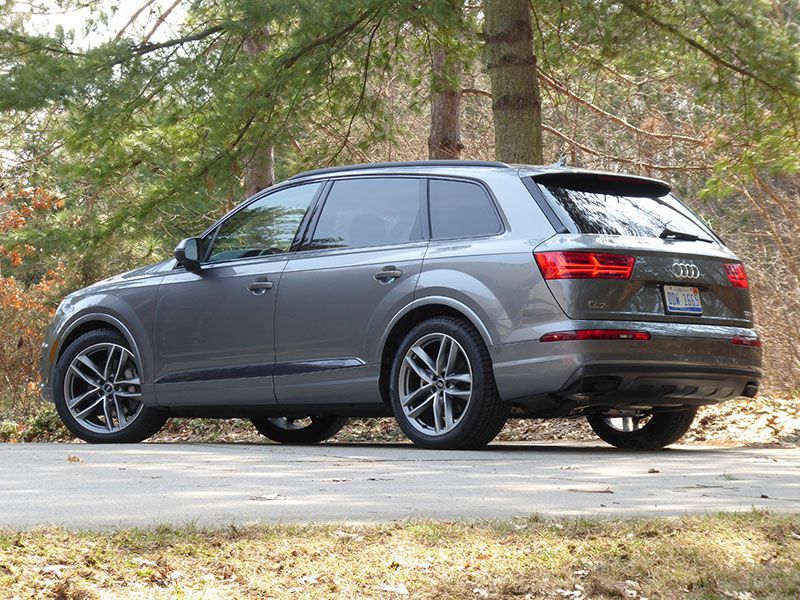Recent Articles
Popular Makes
Body Types
2018 Audi Q7 Road Test and Review
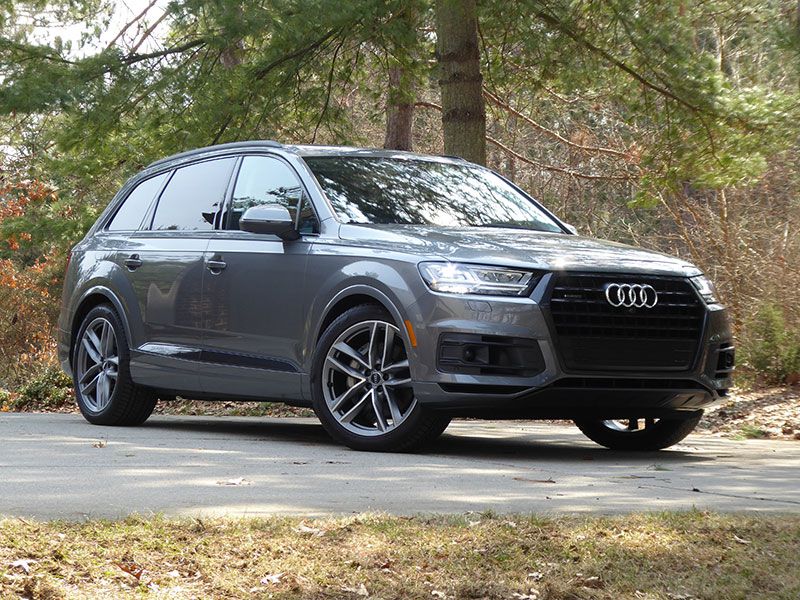
2018 AudiQ7 exterior hero by Ron Sessions ・ Photo by Ron Sessions
Audi’s second-best-selling model in the U.S. last year was its largest SUV, the Q7. That’s likely to continue in 2018, as premium seven-passenger vehicles are a hot commodity with growing families in an improving economy. The Q7's competitors in this segment include the Acura MDX, BMW X5, Infiniti QX60, Buick Enclave, Volvo XC90, and Lexus RX 350L.
An all-new second-generation Q7 was introduced just last year, using more aluminum to reduce weight — improving dynamics and reducing fuel usage. It also incorporates the latest advances in semi-autonomous safety and infotainment technology. Prices start at just over $50,000 for the base Premium trim 2.0T model but can quickly escalate to well north of $80,000 on Premium Plus and Prestige trim 3.0T versions with several of Audi’s tantalizing option packages added to the tally.
Boosted Performance
The Q7 offers a choice of two boosted engines: a 252-hp turbocharged 2.0-liter four-cylinder in the 2.0T or a 333-hp supercharged 3.0-liter V6 in the 3.0T. The former is essentially the same engine that powers the lighter Q5 SUV and A4 and A6 sedans. But even with its recent weight reduction, the Q7 weighs nearly 2.5 tons. So the turbo four has to work harder in the stouter Q7, sometimes resulting in noticeable turbo lag. Audi estimates 0-60 mph performance in just over 7 seconds. And fuel economy is middling at best with EPA ratings of 19 mpg city/25 mpg highway/21 mpg combined.
The 3.0T costs an extra $6,500 but its supercharged V6 fits the grand character of the Q7, more worthy of Audi's flagship SUV. Trailer towing ability rises to 7,700 pounds, up considerably from the 4-cylinder’s 4,000 lbs, and 0-60 times drop well below 6 seconds. Interestingly, the V6 gets the exact same EPA fuel economy estimates as the four-cylinder, likely because the more robust V6 barely works up a sweat. All Q7s use a quick-shifting eight-speed Tiptronic automatic transmission and Audi’s legendary Quattro all-wheel drive.
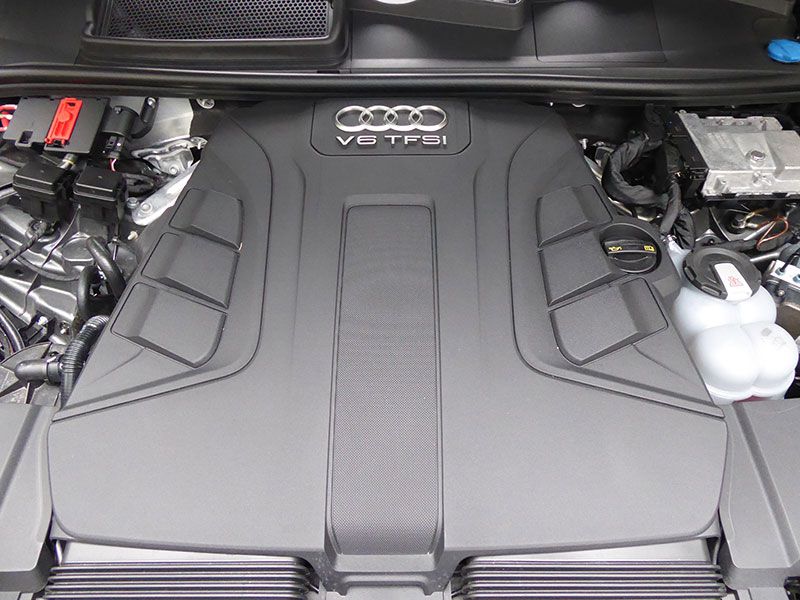
Photo by Ron Sessions
Dashing Cabin
Audi has been setting the interior design bar high for years, and the Q7 delivers in a big way. The cabin is simultaneously functional and stylish, achieving that rare balance of good taste and contemporary funk. Double-inlay trim like in the A8 ultra-luxury car graces the dash, imparting a sport sedan-like ambiance. Meanwhile, ambient LED lighting in subtle hues adds drama — especially during night driving — accenting the console, instrument panel and door trim panels with a flourish.
The cabin is hushed and calm, and the front bucket seats are supremely comfortable and supportive. Attention to detail and fit and finish rank at the top of the class.
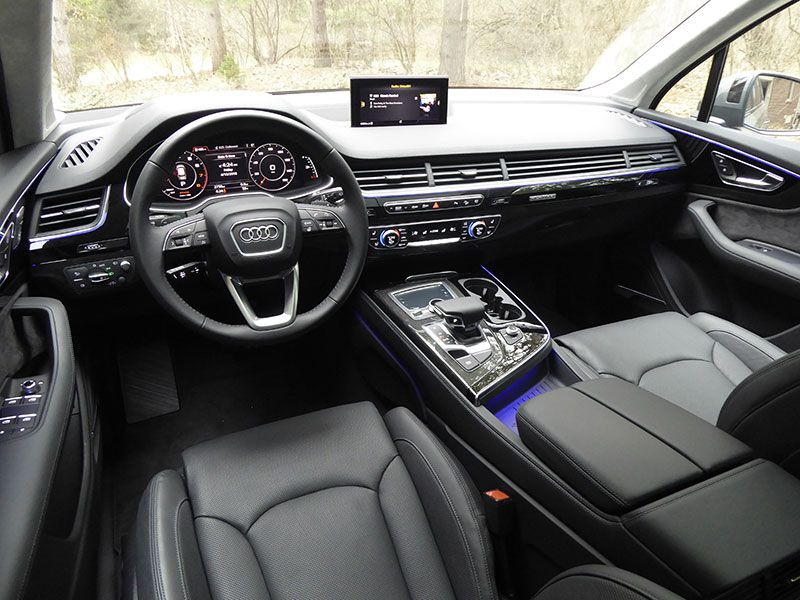
Photo by Ron Sessions
Infotainment Universe
If you're new to Audis, you might have expected the Q7's high-resolution infotainment display to be a touchscreen. It's not. Audi's MMI system, whose screen measures 7 inches on base models and 8.3 inches in the Premium Plus and Prestige trims, is instead operated using controls on the dashboard and console. It takes a bit of time to sort out the functions of the console-mounted buttons, haptic touch controls, and nicely weighted control dial located between the transmission shifter and dash. There’s even a handwriting recognition function for the control pad in Premium Plus and Prestige versions.
Once you master these tools, MMI is your window to the Q7’s standard 10-speaker AM/FM/CD stereo with MP3 playback, HD radio, and SiriusXM satellite radio, Bluetooth connectivity and streaming audio capability, and of course Apple CarPlay and Android Auto smartphone integration. There are two optional surround sound systems: a 558-watt, 19-speaker Bose setup and a Richter scale-worthy 1,920-watt, 23-speaker one from Bang & Olufsen.
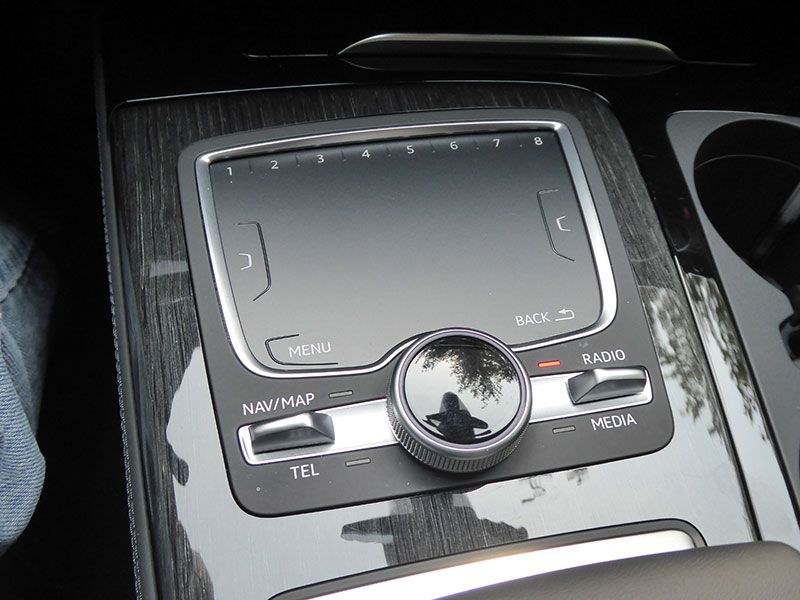
Photo by Ron Sessions
Virtual Cockpit
One of the neater features in the Q7 is the Virtual Cockpit. Included with Prestige trim or the optional Vision package that also includes a 360-degree overhead camera, it’s a driver-configurable 12.3-inch high-resolution screen that replaces the standard gauge layout of a large speedometer and tachometer.
The driver can choose among the several different dash gauge and information displays the driver can choose from using steering wheel buttons. One of these minimizes the speedometer and tachometer and brings the navigation screen in front of the driver. The map has stunning Google Earth birds-eye-view topographic detail showing buildings, landscapes, and roads as if a drone were always broadcasting live imagery from a few hundred feet overhead.
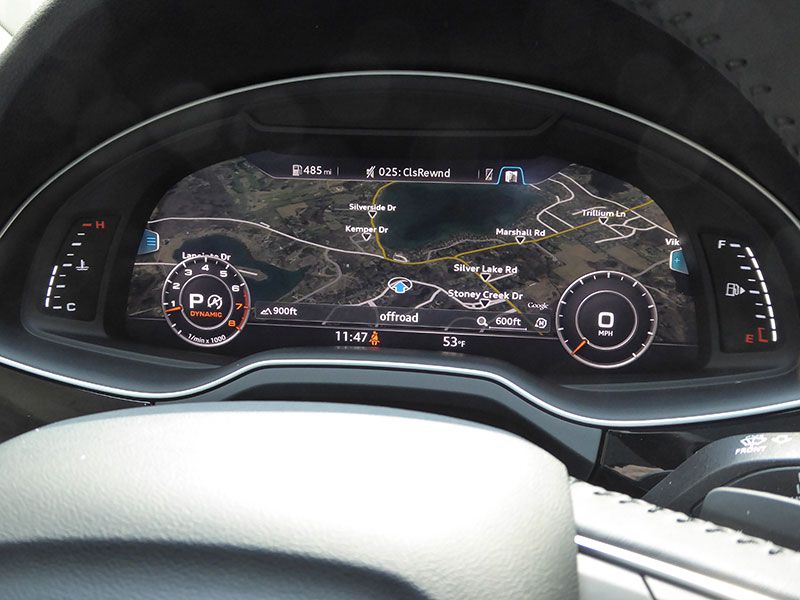
Photo by Ron Sessions
Well-Equipped
Every Q7, regardless of trim level, comes equipped with a standard twin-panel panoramic sunroof with sunshade, slide, and tilt features. Combined with the generous glass area, elevated seating with roomy first- and second-row chairs, and thinner roof pillars, the window to the sky gives the Q7 an open, airy feeling often missing in big SUVs.
Three-zone automatic climate control, leather seating surfaces, and heated power front seats come standard. Nice as they are, these can be upgraded with buttery Valcona leather, four-zone climate control, ventilated and massaging front seats, and heated rear seats, power soft-closing doors, and more. A standard wireless charger for Qi-enabled phones and tablets graces the console, while a head-up display and a power-adjustable steering column are also available.

Photo by Ron Sessions
Details, Details
It’s sometimes the little details that separate really thoughtful designs from commonplace ones. The Q7 incorporates dual sun visors for both the driver and front passenger. These include extendable sun visors that pivot out to shade the side windows plus a second set of visors that flip down to protect from glare at the top of the windshield.
Meanwhile, the blind-spot monitoring system on middle and upper trims goes the extra mile for safety. It replaces the more common pinky-finger-size warning icon on the mirror with a much larger set of bright, impossible-to-ignore yellow LEDs on the inside face of the mirror housing.
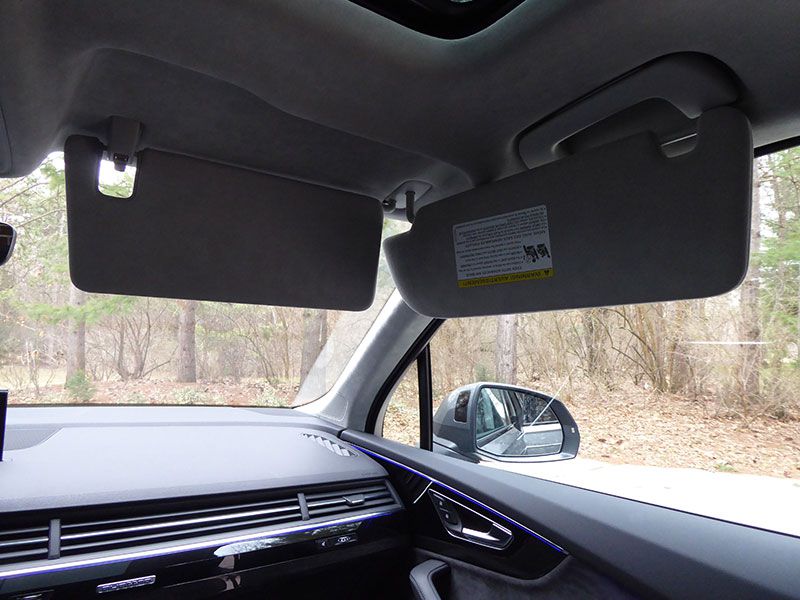
Photo by Ron Sessions
Roomy Second Row
The Q7's second-row seat is nearly as roomy as the fronts. The middle piece of the split 35/30/35 second-row seat folds down to form an armrest and console, while the outboard sections tumble and pivot forward to grant a small measure of third-row access.
All three sections can be folded flat for maximum cargo capacity, and they can slide fore and aft to apportion available legroom where it’s needed. The second-row seats also recline, and uplevel trims add seat heaters. There are five LATCH child seat anchor points — three for the second row and two for the third.
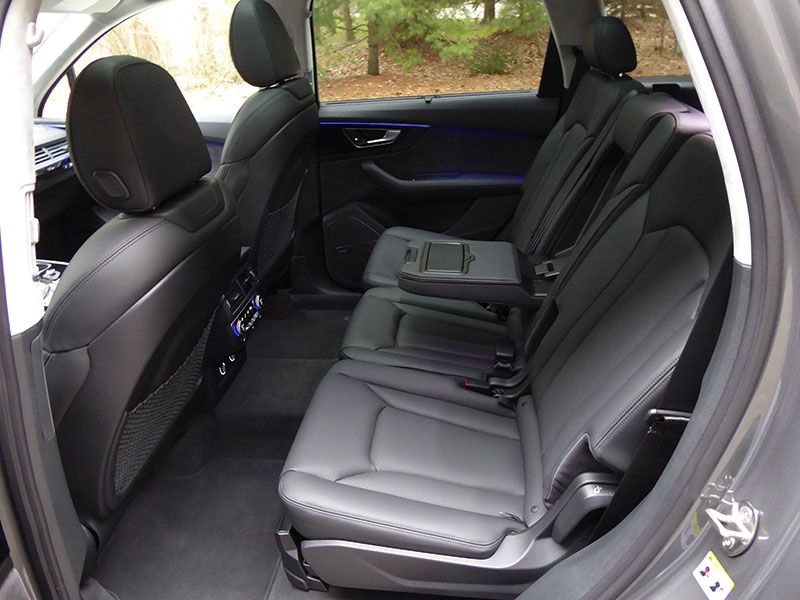
Photo by Ron Sessions
Tight Third Row
As with most of today’s seven-passenger crossover suvs, don’t think that capacity applies to adults. The 2018 Audi Q7 should be considered a 5+2-seater. Unlike true seven-seaters such as the Cadillac Escalade, Buick Enclave, or even Volkswagen Atlas, the Q7 doesn’t offer enough third-row legroom to comfortably transport adults any distance.
Although Audi does provide a pair of LATCH child-seat anchor points for the third row, access to those seats is a bit restricted. Wee folks who've outgrown child safety seats but aren't too long-legged can fit back there after sliding the second-row seats forward a bit. The 50/50 split third-row seat includes power folding and raising, facilitating cargo-hauling.
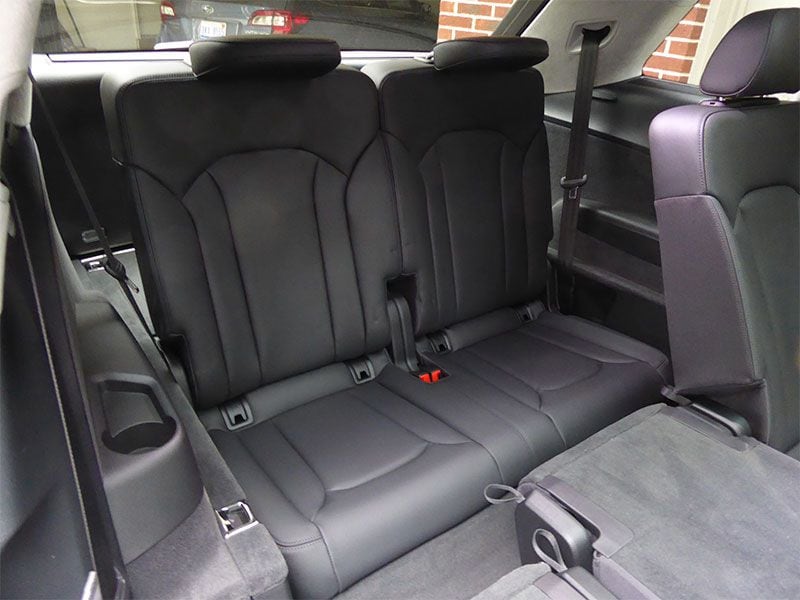
Photo by Ron Sessions
Lost in Space
Even with the third-row seat up, up the Q7 offers 14.8 cubic feet of cargo space, in line with an A6 or A8 sedan's trunk. Fold the third row down and that space balloons to 37.5 cubic feet, and a cavernous 71.6 with both second- and third-row seats down.
Additionally, there are some nooks and crannies for small items like digital cameras and such under the rear cargo floor. This space also houses the amplifier, subwoofer, and electronics of the optional surround-sound audio systems. But you won’t find a spare tire there; the Q7 rolls on extended mobility tires, which take much of the bother out of changing a flat tire in some awful place. A power liftgate comes standard while an optional hands-free hatch feature is also available.
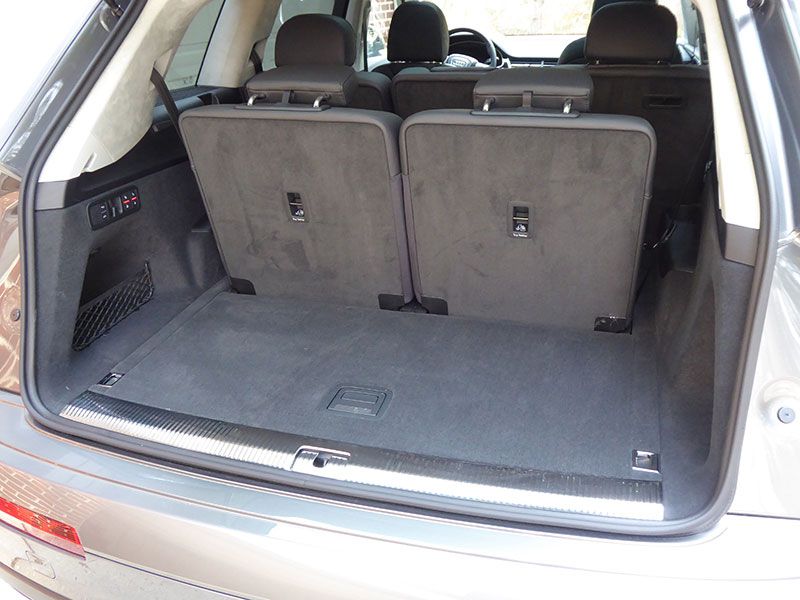
Photo by Ron Sessions
Dynamically Speaking
Despite the Q7’s roominess and impressive capabilities, it drives smaller than it looks. That is to say, it goes, turns and stops with carlike agility, handling corners with composure. Standard brake-based torque vectoring improves the big SUV’s steering response, momentarily applying an inside rear brake to reduce understeer on turn-in. By turning the rear wheels slightly in the same or opposite direction of the fronts, optional four-wheel steering both enhances high-speed stability and aids around-town maneuverability.
The Q7 remains surprisingly flat in corners, even more so with the optional adaptive air suspension. This feature not only enhances handling precision when the standard Audi Drive Select system is in Dynamic mode, but it also makes the Q7 a comfortable long-distance cruiser with Drive Select dialed to Efficiency, Comfort, or Auto modes. Big-diameter four-wheel disc brakes inspire confidence. Both all-season and summer performance run-flat tires are available; wheel sizes range from 18 to a wheel-well-stuffing 21 inches.
